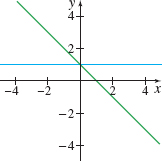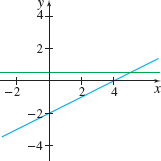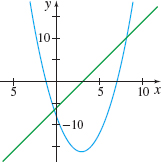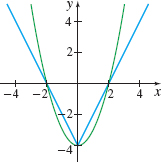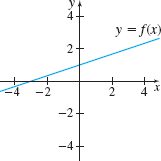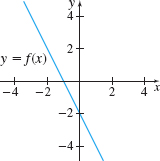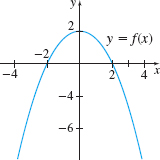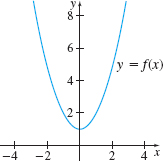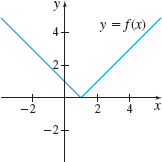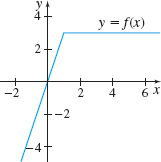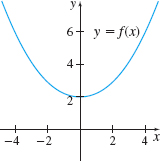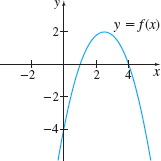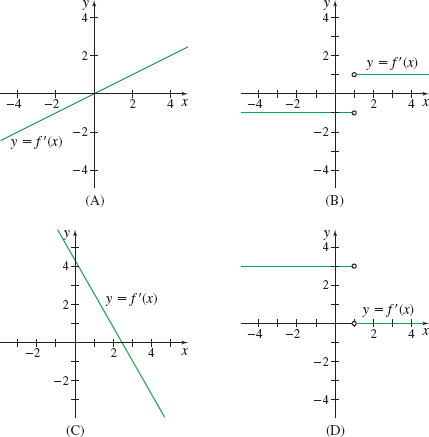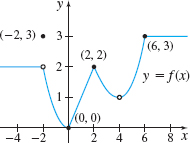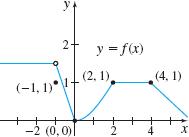2.2 Assess Your UnderstandingPrinted Page 160
Concepts and Vocabulary
True or False The domain of a function f and the domain of its derivative function f′ are always equal.
False
True or False If a function is continuous at a number c, then it is differentiable at c.
False
Multiple Choice If f is continuous at a number c and if limx→cf(x)−f(c)x−c is infinite, then the graph of f has [(a) a horizontal, (b) a vertical, (c) no] tangent line at c.
(b) Vertical
The instruction “Differentiate f” means to find the ____ of f.
derivative
Skill Building
In Problems 5–10, find the rate of change of each function f at any real number c.
f(x)=10
0
f(x)=−4
f(x)=2x+3
2
f(x)=3x−5
f(x)=2−x2
−2c
f(x)=2x2+4
In Problems 11–16, differentiate each function f and determine the domain of f′. Use form (3) on page 154.
f(x)=5
f′(x)=0, all real numbers
f(x)=−2
f(x)=3x2+x+5
f′(x)=6x+1, all real numbers
f(x)=2x2−x−7
f(x)=5√x−1
f′(x)=52√x−1, x>1
f(x)=4√x+3
In Problems 17–22, differentiate each function f. Graph y=f(x) and y=f′(x) on the same set of coordinate axes.
f(x)=13x+1
f′(x)=13
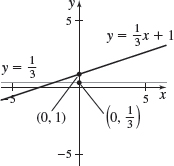
f(x)=−4x−5
f(x)=2x2−5x
f′(x)=4x−5
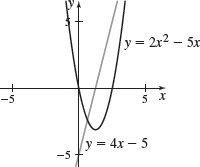
f(x)=−3x2+2
f(x)=x3−8x
f′(x)=3x2−8
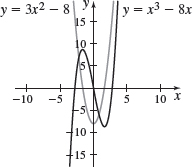
f(x)=−x3−8
In Problems 23–26, for each figure determine if the graphs represent a function f and its derivative f′. If they do, indicate which is the graph of f and which is the graph of f′.
Not a graph of f and f′
Graph of f and f′. The black curve is the graph of f; the gray curve is the graph of f′.
In Problems 27–30, use the graph of f to obtain the graph of f′.
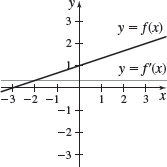
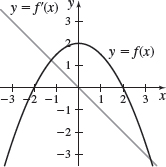
In Problems 31–34, the graph of a function f is given. Match each graph to the graph of its derivative f′ in A–D.
(B)
161
(A)
In Problems 35–44, determine whether each function f has a derivative at c. If it does, what is f′(c)? If it does not, give the reason why.
f(x)=x2/3 at c=−8
f′(−8)=−13
f(x)=2x1/3 at c=0
f(x)=|x2−4| at c=2
f′(2) does not exist.
f(x)=|x2−4| at c=−2
f(x)={ 2x+3ifx<1x2+4ifx≥1atc=1
f′(1)=2
f(x)={ 3−4xifx<−12x+9ifx≥−1atc=−1
f(x)={ −4+2xifx≤124x2−4ifx>12atc=12
f′(12) does not exist.
f(x)={ 2x2+1ifx<−1−1−4xifx≥−1atc=−1
f(x)={ 2x2+1ifx<−12+2xifx≥−1atc=−1
f′(−1) does not exist.
f(x)={ 5−2xifx<2x2ifx≥2atc=2
In Problems 45 and 46, use the given points (c,f(c)) on the graph of the function f.
- (a) For which numbers c does limx→cf(x) exist but f is not continuous at c?
- (b) For which numbers c is f continuous at c but not differentiable at c?
- (a) −2 and 4
- (b) 0, 2, 6
Heaviside Functions In Problems 47 and 48:
- (a) Determine if the given Heaviside function is differentiable at c.
- (b) Give a physical interpretation of each function.
u1(t)={0ift<11ift≥1 at c=1
- (a) u′1(1) does not exist.
- (b) u1(t) models a switch that is off when t<1 and on when t≥1.
u3(t)={0ift<31ift≥3 at c=3
In Problems 49–52, find the derivative of each function.
f(x)=mx+b
f′(x)=m
f(x)=ax2+bx+c
f(x)=1x2
f′(x)=−2/x3
f(x)=1√x
Applications and Extensions
In Problems 53–60, each limit represents the derivative of a function f at some number c. Determine f and c in each case.
limh→0(2+h)2−4h
f(x)=x2, c=2
limh→0(2+h)3−8h
limx→1x2−1x−1
f(x)=x2, c=1
limx→1x14−1x−1
limx→π/6sinx−12x−π6
f(x)=sinx, c=π6
limx→π/4cosx−√22x−π4
limx→02(x+2)2−(x+2)−6x
f(x)=2(x+2)2−(x+2),c=0
limx→03x3−2xx
For the function f(x)={x3ifx≤0x2ifx>0, determine whether:
- (a) f is continuous at 0.
- (b) f′(0) exists.
- (c) Graph the function f and its derivative f′.
- (a) Continuous at 0
- (b) f′(0)=0
- (c)
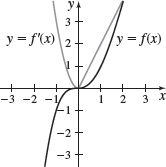
162
For the function f(x)={2xifx≤0x2ifx>0, determine whether:
- (a) f is continuous at 0.
- (b) f′(0) exists.
- (c) Graph the function f and its derivative f′.
Velocity The distance s (in feet) of an automobile from the origin at time t (in seconds) is given by s=s(t)={t3if0≤t<5125ift≥5 (This could represent a crash test in which a vehicle is accelerated until it hits a brick wall at t=5s.)
- (a) Find the velocity just before impact (at t=4.99s) and just after impact (at t=5.01s).
- (b) Is the velocity function v=s′(t) continuous at t=5?
- (c) How do you interpret the answer to (b)?
- (a) s′(4.99)=74.7003 ft/s; s′(5.01)=0 ft/s
- (b) Not continuous
- (c) Answers will vary.
Population Growth A simple model for population growth states that the rate of change of population size P with respect to time t is proportional to the population size. Express this statement as an equation involving a derivative.
Atmospheric Pressure Atmospheric pressure p decreases as the distance x from the surface of Earth increases, and the rate of change of pressure with respect to altitude is proportional to the pressure. Express this law as an equation involving a derivative.
dpdx=−kp, k>0.
Electrical Current Under certain conditions, an electric current I will die out at a rate (with respect to time t) that is proportional to the current remaining. Express this law as an equation involving a derivative.
Tangent Line Let f(x)=x2+2. Find all points on the graph of f for which the tangent line passes through the origin.
(√2,4) and (−√2,4)
Tangent Line Let f(x)=x2−2x+1. Find all points on the graph of f for which the tangent line passes through the point (1,−1).
Area and Circumference of a Circle A circle of radius r has area A=πr2 and circumference C=2πr. If the radius changes from r to r+Δr, find the:
- (a) Change in area
- (b) Change in circumference
- (c) Average rate of change of area with respect to radius
- (d) Average rate of change of circumference with respect to radius
- (e) Rate of change of circumference with respect to radius
- (a) 2πr(Δr)+π(Δr)2
- (b) 2πΔr
- (c) 2πr+πΔr
- (d) 2π
- (e) 2π
Volume of a Sphere The volume V of a sphere of radius r is V=4πr33. If the radius changes from r to r+Δr, find the:
- (a) Change in volume
- (b) Average rate of change of volume with respect to radius
- (c) Rate of change of volume with respect to radius
Use the definition of the derivative to show that f(x)=|x| has no derivative at 0.
See Student Solutions Manual.
Use the definition of the derivative to show that f(x)=3√x has no derivative at 0.
If f is an even function that is differentiable at c, show that its derivative function is odd. That is, show f′(−c)=−f′(c).
See Student Solutions Manual.
If f is an odd function that is differentiable at c, show that its derivative function is even. That is, show f′(−c)=f′(c).
Tangent Lines and Derivatives Let f and g be two functions, each with derivatives at c. State the relationship between their tangent lines at c if:
- (a) f′(c)=g′(c)
- (b) f′(c)=−1g′(c)
- (c) g′(c)≠0
- (a) Parallel
- (b) Perpendicular
Challenge Problems
Let f be a function defined for all x. Suppose f has the following properties: f(u+v)=f(u)f(v)f(0)=1f′(0) exists
- (a) Show that f′(x) exists for all real numbers x.
- (b) Show that f′(x)=f′(0)f(x).
A function f is defined for all real numbers and has the following three properties: f(1)=5f(3)=21f(a+b)−f(a)=kab+2b2 for all real numbers a and b where k is a fixed real number independent of a and b.
- (a) Use a=1 and b=2 to find k.
- (b) Find f′(3).
- (c) Find f′(x) for all real x.
- (a) k=4
- (b) f′(3)=12
- (c) f′(x)=4x
A function f is periodic if there is a positive number p so that f(x+p)=f(x) for all x. Suppose f is differentiable. Show that if f is periodic with period p, then f′ is also periodic with period p.

